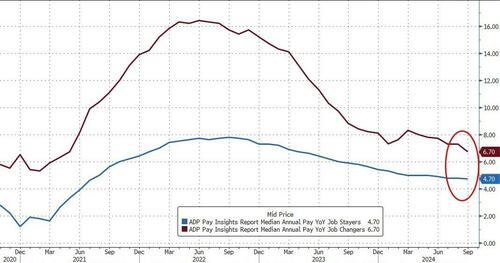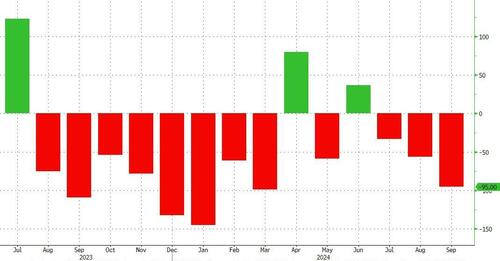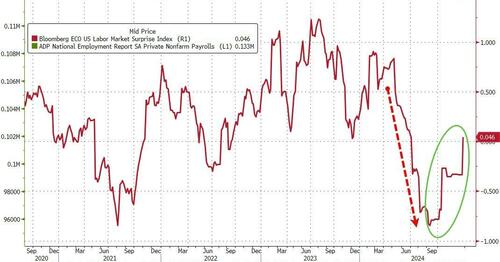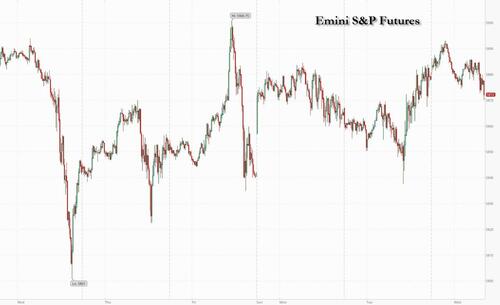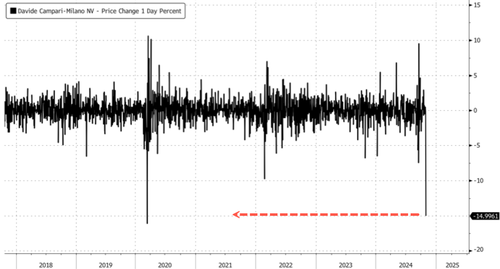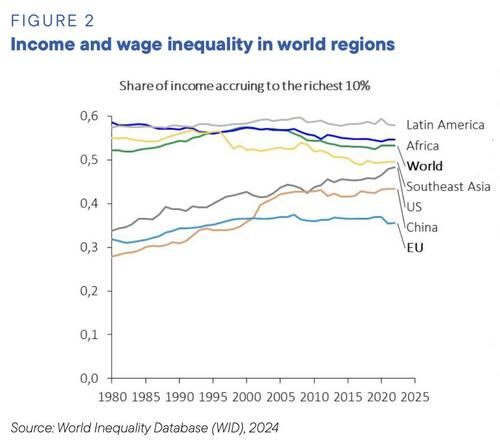Authored by James Rickards via DailyReckoning.com,
There’s so much to discuss right now, from the upcoming election to geopolitical instability. But today I want to talk about gold. I call it the once — and future — money.

The use of gold as money existed from antiquity until gold backing broke down entirely in 1971. Still, central banks and finance ministries hold over 37,000 metric tonnes of gold in reserve.
Why? The answer is that gold is still at the base of global monetary systems. It’s simply the case that no government wants to admit this because the shortage of gold relative to bank notes would be exposed if they did.
But gold is coming to the fore of the monetary system again. Central banks are buying gold as fast as they can. Let’s look at some pertinent data before turning to the key geo-economic trends that will drive the dollar price of gold much higher in the near future.
The dollar price of gold today is $2,754 per ounce (subject to the usual daily fluctuations). As recently as Nov. 3, 2022, gold was $1,630. That’s a 69% gain in under two years. Gold was $1,375 per ounce in early June 2019.
That means the dollar price of gold has doubled in just over five years.
Most of the gains over that period have occurred in the past year. Gold was still $1,845 in October 2023. Whether we consider a multiyear trend or a more recent trend, gold has moved steadily higher with dramatic momentum lately.
There’s a simple but important bit of math behind these price moves that investors should understand. It’s the key to making huge profits in gold in the months ahead.
Investors tend to focus on the dollar price of gold and to analyze the price in round numbers. That makes sense.
If gold goes up $100 per ounce and you own 500 ounces, that’s a $50,000 profit. Another $100 per ounce gain means another $50,000 profit. That’s real money for you.
What investors may not realize at first is that each $100 gain (and $50,000 profit) is easier than the one before.
That’s because each gain is measured in constant $100 increments, but the measurement begins from a higher base. A constant dollar gain is a smaller percentage of an expanding base so it’s easier to achieve in percentage terms.
For example, if the price goes from $2,500 to $2,600 per ounce, that’s a 4% gain. But if the price goes from $2,900 to $3,000 per ounce (same $100 gain), that’s a 3.5% gain. Obviously, a 3.5% gain is easier to pick up than a 4.0% gain, but it’s the same $100 gain and $50,000 profit in your pocket.
This dynamic is even more dramatic if we look at $1,000 price increases. (That means $500,000 in profits if you own 500 ounces). When the price moves from $2,000 per ounce to $3,000 per ounce, that’s a 50% gain.
But when the price moves from $9,000 per ounce to $10,000, that’s only an 11% gain. Same $1,000 per ounce gain and same $500,000 in profit, but a much easier hurdle to move 11% compared with 50%.
The math is obvious, but the psychology is not. And investor psychology is the engine that will drive gold prices to much higher levels faster than most investors can imagine.
Below, I show you why gold is poised to blast off. Read on.
Gold Is on the Launchpad
The last time gold was taken seriously as a monetary asset was in the mid-1970s. The last time that retail investors had much appetite for gold investing was in the early 1980s. Gold hit $800 in January 1980. That was the all-time high at the time. Gold was flat to down from 1981–1999, hitting $250 per ounce in 1999 at the end of a 20-year bear market.
From there, gold reached a new high of $1,900 per ounce in August 2011, a 670% gain in 12 years. Then gold fell into a second bear market, falling $850 to $1,050 per ounce in December 2015. That was a 45% crash from the 2011 high.
If you treat the 1999 low of $250 per ounce as a baseline, the 2011–2015 crash was actually 51.5%: (850 / 1650 = 51.5%). That calculation is important. Jim Rogers, the greatest commodity trader of all time, told me that no commodity goes to the moon without a 50% correction along the way. Gold had its 50% correction in 2015. Now it’s off to the moon.
The point is that despite two bull markets (1971–1980 and 1999–2011) and two bear markets (1981–1999 and 2011–2015), gold investing never captured the popular imagination in the way that housing did in the early 2000s or that stocks have today.
Individual investors have been in and out of the market and investors from the early 2000s have done quite well. Hedge funds trade momentum but get out at the first speed bump. They don’t think of gold any differently than they do soybeans or oil. It’s just a trade.
The institutional investor footprint in the gold market is almost non-existent. From an investment perspective, gold has been an orphan asset with a few supporters but not many. That’s all about to change radically. Here’s why:
The first key to gold’s coming surge is the role of central banks. Retail and institutional investors may not be that interested in gold, but central banks definitely are. In recent years, central bank holdings of gold have surged from 33,000 metric tonnes to over 37,000 metric tonnes, a 12.0% gain measured by weight.
This increase has been heavily concentrated in two countries — Russia and China. Russian gold reserves have risen from 600 metric tonnes in 2008 to 2,335 metric tonnes today, a gain of 1,735 metric tonnes or nearly 200% from the 2008 base.
China also had about 600 metric tonnes in 2008 and today has 2,264 metric tonnes, a 275% gain. (There is good reason to conclude that China has undisclosed gold reserves, which would make those total and percentage gains ever higher).

Source: TalkMarkets
The Big 10 holders of gold include the usual suspects — The U.S., Germany, Italy, France, Switzerland and Japan. But the list also includes some newcomers such as Russia, China and India.
Other important countries are vying for a place in the global gold club. In the second quarter of 2024 (most recent available data), Poland added 18.7 tonnes, India added 18.7 tonnes, Turkey added 14.7 tonnes, Uzbekistan added 7.5 tonnes and the Czech Republic added 5.89 tonnes.
Why the large gold holdings and why the rapid additions to gold reserves if gold is not a monetary asset? The question answers itself. Gold is a monetary asset.
Central bank net buying is equivalent to about 20% of annual gold mining output. That doesn’t indicate a gold shortage, but it does put a firm floor under the dollar price of gold. That creates what we call an asymmetric trade.
On the upside, the sky’s the limit, but on the downside, the central banks have your back to some extent because they will definitely buy the dips to increase their gold hoards. That’s the best type of trade to be in.
So the stage is set. The simple math of easier percentage gains for constant dollar gains is the dynamic that can set off a buying frenzy and lead to super-spikes in the dollar price of gold. Central bank buying causes a relentless increase in the dollar price of gold and offers limited downside because they will buy the dips. All that is needed to set off the super-spike is an unexpected development that is not already priced in.
Now we have it. The BRICS met in Kazan, Russian Federation last week. The BRICS have a rotating presidency and this year Putin is president of the BRICS. The world is waiting for the announcement of a new BRICS currency. That may come in time, but not yet. The new currency may be 10 years away.
What happened instead was that Putin and the BRICS announced a new blockchain-based digital ledger to record trade payments using existing currencies of the BRICS members. The significance of this system (tentatively named “BRICS Clear”) is that there are no dollars involved and the secure payment channels are relatively safe from U.S. and EU sanctions.
Russia will sell oil to China for rubles, Brazil will sell aircraft to China for reais and India will sell technology to China for rupees and so on. (Alternatively, any BRICS member can elect to take the currency of any other BRICS member, all to be recorded on BRICS Clear).
Payments can be settled on a net basis instead of a gross basis. This means, for example, that Russia and China can trade goods and record payments. There will be “due to” and “due from” on the ledgers.
Those can be netted out with only the net amount changing hands. And this does not have to be done in real-time; it can be done monthly or quarterly. This greatly reduces the amount of payments and message traffic.
The central bank or commercial banks in each country can provide payments to local sellers in local currency while recording a due from the BRICS Clear ledger on its books.
That system can work well, but it leaves two issues unresolved compared to a single currency system. The first is stability in exchange rates while balances are left unsettled. The second is the overaccumulation of a certain currency by one party that may have limited use for that currency.
If you don’t want to take exchange rate risk, you can take your counterparty currency balances and buy gold. And if you have too much of a certain currency standing on your accounts, you can reduce the balance by buying gold.
The implications of this have not yet sunk into market pricing. It’s tantamount to an informal gold standard without fixed exchange rates. It relies on market forces (mostly denominated in U.S. dollars for now) and does not rely on huge hoards of freely convertible gold in central banks.
Still, it works. It positions gold as an anchor in a new international monetary system without the strictures of the classical gold standard.
The picture is now complete. Gold is on an upward path driven by central bank buying. Gold is poised to go much higher because the BRICS will use physical gold as their anchor instead of U.S. dollars. And investor psychology will cause a super-spike once the big dollar gains become a daily occurrence.
It’s a powder keg and the BRICS have just struck a match. The smartest move for everyday investors is to buy gold now before the fun really begins.



